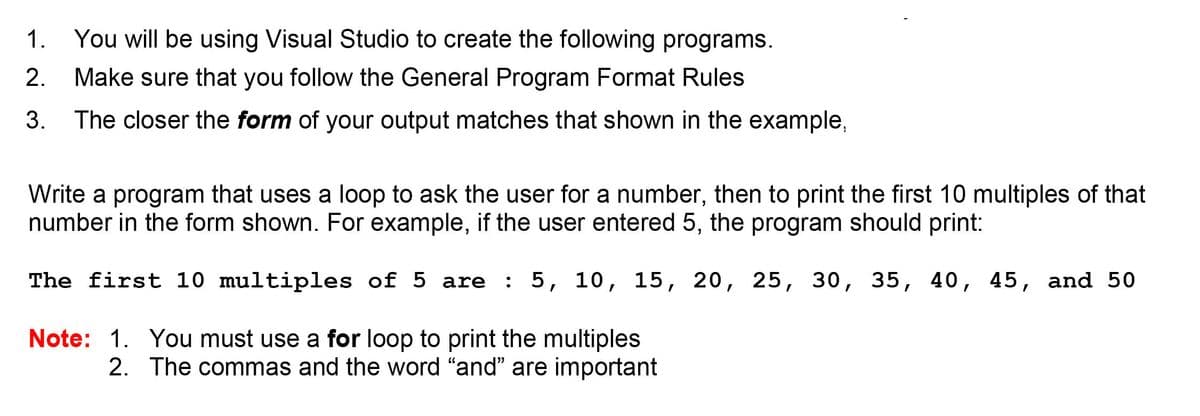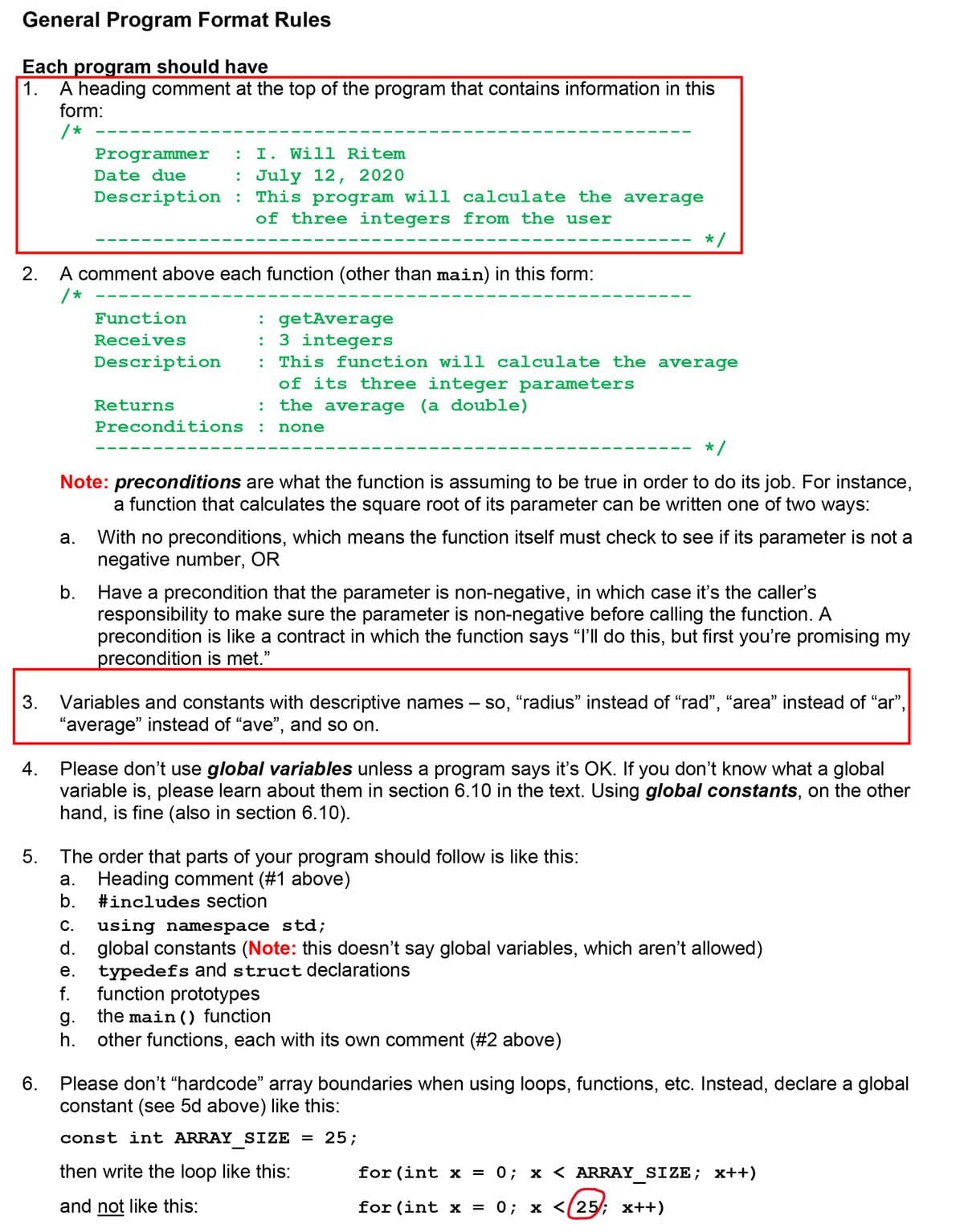1. You will be using Visual Studio to create the following programs. 2. Make sure that you follow the General Program Format Rules 3. The closer the form of your output matches that shown in the example, Write a program that uses a loop to ask the user for a number, then to print the first 10 multiples of that number in the form shown. For example, if the user entered 5, the program should print: The first 10 multiples of 5 are : 5, 10, 15, 20, 25, 30, 35, 40, 45, and 50 Note: 1. You must use a for loop to print the multiples 2. The commas and the word "and" are important
1. You will be using Visual Studio to create the following programs. 2. Make sure that you follow the General Program Format Rules 3. The closer the form of your output matches that shown in the example, Write a program that uses a loop to ask the user for a number, then to print the first 10 multiples of that number in the form shown. For example, if the user entered 5, the program should print: The first 10 multiples of 5 are : 5, 10, 15, 20, 25, 30, 35, 40, 45, and 50 Note: 1. You must use a for loop to print the multiples 2. The commas and the word "and" are important
Database System Concepts
7th Edition
ISBN:9780078022159
Author:Abraham Silberschatz Professor, Henry F. Korth, S. Sudarshan
Publisher:Abraham Silberschatz Professor, Henry F. Korth, S. Sudarshan
Chapter1: Introduction
Section: Chapter Questions
Problem 1PE
Related questions
Question
Hi, I need to answer this question using the C++
Note: I have included a copy of the General Program Format Rules.

Transcribed Image Text:1. You will be using Visual Studio to create the following programs.
2.
Make sure that you follow the General Program Format Rules
3. The closer the form of your output matches that shown in the example,
Write a program that uses a loop to ask the user for a number, then to print the first 10 multiples of that
number in the form shown. For example, if the user entered 5, the program should print:
The first 10 multiples of 5 are : 5, 10, 15, 20, 25, 30, 35, 40, 45, and 50
Note: 1. You must use a for loop to print the multiples
2. The commas and the word "and" are important

Transcribed Image Text:General Program Format Rules
Each program should have
1. A heading comment at the top of the program that contains information in this
form:
/*
Programmer
I. Will Ritem
:
Date due
: July 12, 2020
Description : This program will calculate the average
of three integers from the user
*/
A comment above each function (other than main) in this form:
/ *
: getAverage
: 3 integers
: This function will calculate the average
of its three integer parameters
: the average (a double)
Function
Receives
Description
Returns
Preconditions : none
* /
Note: preconditions are what the function is assuming to be true in order to do its job. For instance,
a function that calculates the square root of its parameter can be written one of two ways:
With no preconditions, which means the function itself must check to see if its parameter is not a
negative number, OR
а.
b. Have a precondition that the parameter is non-negative, in which case it's the caller's
responsibility to make sure the parameter is non-negative before calling the function. A
precondition is like a contract in which the function says "Ill do this, but first you're promising my
precondition is met."
3. Variables and constants with descriptive names
"average" instead of "ave", and so on.
– so, "radius" instead of "rad", "area" instead of "ar",
Please don't use global variables unless a program says it's OK. If you don't know what a global
variable is, please learn about them in section 6.10 in the text. Using global constants, on the other
hand, is fine (also in section 6.10).
4.
The order that parts of your program should follow is like this:
Heading comment (#1 above)
b.
а.
#includes section
using namespace std;
d.
C.
global constants (Note: this doesn't say global variables, which aren't allowed)
typedefs and struct declarations
f.
е.
g.
h.
function prototypes
the main () function
other functions, each with its own comment (#2 above)
6.
Please don't "hardcode" array boundaries when using loops, functions, etc. Instead, declare a global
constant (see 5d above) like this:
const int ARRAY SIZE = 25;
then write the loop like this:
for (int x
= 0; x < ARRAY SIZE; x++)
and not like this:
for (int x = 0; x <(25/; x++)
2.
5.
Expert Solution
This question has been solved!
Explore an expertly crafted, step-by-step solution for a thorough understanding of key concepts.
This is a popular solution!
Trending now
This is a popular solution!
Step by step
Solved in 3 steps with 2 images

Knowledge Booster
Learn more about
Need a deep-dive on the concept behind this application? Look no further. Learn more about this topic, computer-science and related others by exploring similar questions and additional content below.Recommended textbooks for you

Database System Concepts
Computer Science
ISBN:
9780078022159
Author:
Abraham Silberschatz Professor, Henry F. Korth, S. Sudarshan
Publisher:
McGraw-Hill Education

Starting Out with Python (4th Edition)
Computer Science
ISBN:
9780134444321
Author:
Tony Gaddis
Publisher:
PEARSON

Digital Fundamentals (11th Edition)
Computer Science
ISBN:
9780132737968
Author:
Thomas L. Floyd
Publisher:
PEARSON

Database System Concepts
Computer Science
ISBN:
9780078022159
Author:
Abraham Silberschatz Professor, Henry F. Korth, S. Sudarshan
Publisher:
McGraw-Hill Education

Starting Out with Python (4th Edition)
Computer Science
ISBN:
9780134444321
Author:
Tony Gaddis
Publisher:
PEARSON

Digital Fundamentals (11th Edition)
Computer Science
ISBN:
9780132737968
Author:
Thomas L. Floyd
Publisher:
PEARSON

C How to Program (8th Edition)
Computer Science
ISBN:
9780133976892
Author:
Paul J. Deitel, Harvey Deitel
Publisher:
PEARSON

Database Systems: Design, Implementation, & Manag…
Computer Science
ISBN:
9781337627900
Author:
Carlos Coronel, Steven Morris
Publisher:
Cengage Learning

Programmable Logic Controllers
Computer Science
ISBN:
9780073373843
Author:
Frank D. Petruzella
Publisher:
McGraw-Hill Education